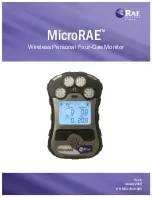
MicroRAE User’s Guide
5
WARNINGS
This Manual must be carefully read by all individuals who have or will have the respon-
sibility of using, maintaining, or servicing this product. The product will perform as
designed only if it is used, maintained, and serviced in accordance with the manufac-
turer’s instructions. The user should understand how to set the correct parameters and
interpret the obtained results.
CAUTION!
•
Only use the RAE Systems rechargeable lithium-ion battery pack supplied with
the instrument.
•
Charge the instrument Li-ion battery using the specifically supplied RAE Systems
charger and only outside hazardous areas. The maximum voltage from the charger
must not exceed 6.0 VDC.
•
Any data download device connected to this instrument must be approved SELV
or Class 2 equipment.
•
Use of non-RAE Systems components will void the warranty and can
compromise the safe performance of this product.
•
Warning: Substitution of components may impair safe performance of this
product.
SPECIAL CONDITIONS FOR SAFE USE
•
This multi-gas monitor must be calibrated if it does not pass a bump test, when a
new sensor has been installed, or at least once every 180 days, depending on use
and sensor exposure to poisons and contaminants
•
No precautions against electrostatic discharge are necessary for portable
equipment that has an enclosure made of plastic, metal or a combination of the
two, except where a significant static-generating mechanism has been identified.
Activities such as placing the item on a belt, operating a keypad or cleaning with a
damp cloth, do not present a significant electrostatic risk. However, where a
static-generating mechanism is identified, such as repeated brushing against
clothing, then suitable precautions shall be taken, e.g., the use of anti-static
footwear.
Note:
Users are recommended to refer to ISA -RP12.13, Part II-1987 for general
information on installation, operation, and maintenance of combustible gas detection
instruments.




















